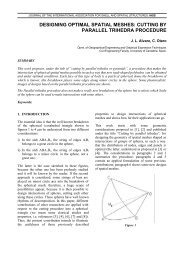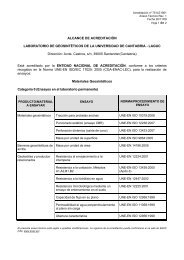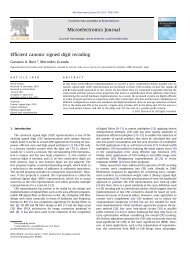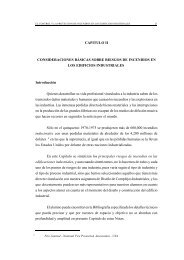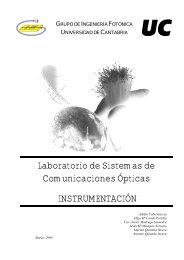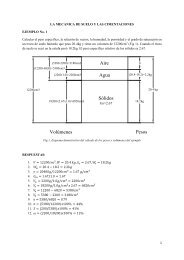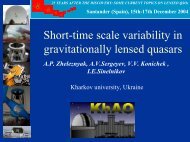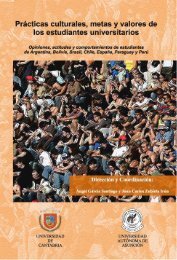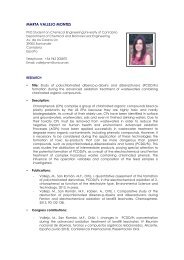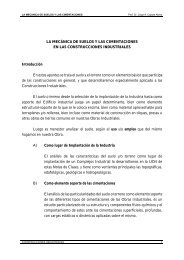XXXVII <str<strong>on</strong>g>IAHS</str<strong>on</strong>g><str<strong>on</strong>g>World</str<strong>on</strong>g> <str<strong>on</strong>g>C<strong>on</strong>gress</str<strong>on</strong>g> <strong>on</strong> <strong>Housing</strong>October 26 – 29, 2010, Santan<strong>de</strong>r, SpainCODE: 252“CONTAINER ARCHITECTURE” FOR LOW-COST,TEMPORARY AND ENERGYSAVING HOUSING DESIGNC. Masotti, A. FerranteFaculty of EngineeringDepartment of Architecture and Urban PlanningUniversity of Bologna, Italyclara.masotti@unibo.it; annarita.ferrante@unibo.itKey words: c<strong>on</strong>tainer, low-cost, temporary, energy saving, housing, emergency, re-use, sustainable.AbstractC<strong>on</strong>tainers, freighter <strong>de</strong>dicated comp<strong>on</strong>ents, present high potential as prefab structures to beused in the building sector, with special regards for emergency and temporary housingc<strong>on</strong>structi<strong>on</strong>.C<strong>on</strong>tainers are portable, available in a c<strong>on</strong>sistent amount, structurally resistant and durable;furthermore they can be easily placed <strong>on</strong> the ground without special foundati<strong>on</strong> works.The possible technologies to be applied in the re-use of c<strong>on</strong>tainers have to be simple andfuncti<strong>on</strong>al, especially in case of emergency settlements. In case of temporary use notexclusively associated to emergency c<strong>on</strong>diti<strong>on</strong>s, aesthetic, envir<strong>on</strong>mental features and lowcost soluti<strong>on</strong>s have to be c<strong>on</strong>si<strong>de</strong>red as important requirements to be addressed. The paper, bymeans of specific comparis<strong>on</strong> am<strong>on</strong>g different use of c<strong>on</strong>tainers in existing prototypebuildings and new <strong>de</strong>sign procedures, outlines the possible structural adaptati<strong>on</strong> to achieve anew housing for a renewed life style, respecting socioec<strong>on</strong>omic and envir<strong>on</strong>mentalsustainability. The different soluti<strong>on</strong>s range from very simple houses, with limitedmodificati<strong>on</strong>s, to highly complex schemes, with high tech materials and plant for achievingself-sufficiency for stand al<strong>on</strong>e or “off the grid” soluti<strong>on</strong>s. The paper also presents a realprototype c<strong>on</strong>tainer’s adaptati<strong>on</strong>, whose progressive c<strong>on</strong>structi<strong>on</strong> phases’ analysis showsseveral <strong>de</strong>sign comp<strong>on</strong>ents at the technological scale of the building.37º <str<strong>on</strong>g>IAHS</str<strong>on</strong>g> <str<strong>on</strong>g>World</str<strong>on</strong>g> <str<strong>on</strong>g>C<strong>on</strong>gress</str<strong>on</strong>g> On <strong>Housing</strong> Science 143
XXXVII <str<strong>on</strong>g>IAHS</str<strong>on</strong>g><str<strong>on</strong>g>World</str<strong>on</strong>g> <str<strong>on</strong>g>C<strong>on</strong>gress</str<strong>on</strong>g> <strong>on</strong> <strong>Housing</strong>October 26 – 29, 2010, Santan<strong>de</strong>r, SpainCODE: 253ENERGY SURVEYS FOR SUSTAINABLE RETROFIT OFEXISTING RESIDENTIAL BUILDINGSGiuseppe Desogusi, Luciano Mareddui, Salvatore Muraii, Roberto Ricciuii, Valeria Saiui,Ant<strong>on</strong>ello SannaiiDepartment of ArchitectureiiDepartment of Mechanical EngineeringUniversity of Cagliarie-mail: g<strong>de</strong>sogus@unica.itKey words: existing resi<strong>de</strong>ntial buildings, survey of energy performance, thermal and envir<strong>on</strong>mentalmeasurements, sustainable retrofit.AbstractDirective 2002/91/EC ma<strong>de</strong> energy certificati<strong>on</strong> for buildings compulsory in every EUmember state.To provi<strong>de</strong> valid certificati<strong>on</strong> it is fundamental to assess the energy performance of new an<strong>de</strong>xisting buildings. In the latter case, the assessment is necessary also to foresee all possibleretrofit strategies.To carry out a correct survey it is indispensable to measure the performances of opaque andtransparent comp<strong>on</strong>ents of the envelope, c<strong>on</strong>sumpti<strong>on</strong>s of HVAC services and the evaluati<strong>on</strong>of thermal comfort insi<strong>de</strong> the buildings.For these reas<strong>on</strong>s, the authors have <strong>de</strong>veloped a methodology for energy surveys of existingbuildings and experimented it in several test cases for over a year. The methodology inclu<strong>de</strong>sthe use of instruments such as heat flux meters, IR cameras and microclimatic data loggers.To reach this goal, it was first necessary to adapt internati<strong>on</strong>al measurement standards toMediterranean climatic c<strong>on</strong>diti<strong>on</strong>s (especially for the measures of thermal transmittance).Then a survey method was set up and tested <strong>on</strong> several existing resi<strong>de</strong>ntial buildings. Thestudy cases were chosen basically from am<strong>on</strong>g traditi<strong>on</strong>al Sardinian houses ma<strong>de</strong> of earthbricks and more recent lowcost housing.The outcome of the research is firstly the proposal of an integrated assessment method forenergy performances of resi<strong>de</strong>ntial buildings, <strong>on</strong>e that inclu<strong>de</strong>s the use of differentmeasurement instruments, and which is the basis for correct certificati<strong>on</strong>. The research is alsothe starting point from which to propose different examples of possible retrofitting strategies<strong>on</strong> existing buildings, both traditi<strong>on</strong>al and mo<strong>de</strong>rn, and their ec<strong>on</strong>omic advantages.37º <str<strong>on</strong>g>IAHS</str<strong>on</strong>g> <str<strong>on</strong>g>World</str<strong>on</strong>g> <str<strong>on</strong>g>C<strong>on</strong>gress</str<strong>on</strong>g> On <strong>Housing</strong> Science 144
- Page 1 and 2:
University ofCantabriawww.iahshousi
- Page 3 and 4:
ÍNDICE1. HONORARY COMMITTEE ______
- Page 5 and 6:
2. INTRODUCTIONThe International As
- Page 7:
4. ENTIDADES COLABORADORASColegio d
- Page 10 and 11:
6. ORGANIZING COMMITTEELOCAL ORGANI
- Page 12 and 13:
8. TOPICS - STATISTICSTOPIC I: MATE
- Page 14 and 15:
also the Spanish aristocracy used t
- Page 16 and 17:
11. CONFERENCE ROOMSThe Con
- Page 18 and 19:
Also, the Congress
- Page 20 and 21:
13. PLENARY SESSIONSPLENARY SESSION
- Page 22 and 23:
October 26, 9 h 30-10 h 00 (Room 0)
- Page 24 and 25:
October 26, 10 h 30-11 h 00 (Room 0
- Page 26 and 27:
October 27, 9 h 30-10 h 00 (Room 0)
- Page 28 and 29:
October 27, 10 h 30-11 h 00 (Room 0
- Page 30 and 31:
October 28, 9 h 30-10 h 00 (Room 0)
- Page 32 and 33:
October 28, 10 h 30-11 h 00 (Room 0
- Page 34 and 35:
October 26, 201011 h 30-13 h 30 Cha
- Page 36 and 37:
October 26, 201011 h 30-13 h 30 Cha
- Page 38 and 39:
October 27, 201011 h 30-13 h 30 Cha
- Page 40 and 41:
October 27, 201011 h 30-13 h 30 Cha
- Page 42 and 43:
October 28, 201011 h 30-13 h 30 Cha
- Page 44 and 45:
October 28, 201011 h 30-13 h 30 Cha
- Page 46 and 47:
16. TECHNICAL EXPOSITION (STANDS)37
- Page 48 and 49:
TRIP A: MARITIME MUSEUM + PEDREÑA
- Page 50 and 51:
RECEPTION COCKTAIL BY THE MAYOR OFS
- Page 52 and 53:
37º IAHS
- Page 54 and 55:
GALA DINNERDía 28 de OctubrePassin
- Page 56 and 57:
37º IAHS
- Page 58 and 59:
19. ABSTRACTS OF THE CONGRESSABSTRA
- Page 60 and 61:
XXXVII IAHS<strong
- Page 62 and 63:
XXXVII IAHS<strong
- Page 64 and 65:
XXXVII IAHS<strong
- Page 66 and 67:
XXXVII IAHS<strong
- Page 71 and 72:
XXXVII IAHS<strong
- Page 73 and 74:
XXXVII IAHS<strong
- Page 75 and 76:
XXXVII IAHS<strong
- Page 77 and 78:
XXXVII IAHS<strong
- Page 79 and 80:
XXXVII IAHS<strong
- Page 81 and 82:
XXXVII IAHS<strong
- Page 83 and 84:
XXXVII IAHS<strong
- Page 85 and 86:
XXXVII IAHS<strong
- Page 87 and 88:
XXXVII IAHS<strong
- Page 89 and 90:
XXXVII IAHS<strong
- Page 91 and 92:
XXXVII IAHS<strong
- Page 93 and 94:
XXXVII IAHS<strong
- Page 95 and 96: XXXVII IAHS<strong
- Page 97 and 98: XXXVII IAHS<strong
- Page 99 and 100: XXXVII IAHS<strong
- Page 101 and 102: XXXVII IAHS<strong
- Page 103 and 104: XXXVII IAHS<strong
- Page 105 and 106: XXXVII IAHS<strong
- Page 107 and 108: XXXVII IAHS<strong
- Page 109 and 110: XXXVII IAHS<strong
- Page 111 and 112: XXXVII IAHS<strong
- Page 113 and 114: XXXVII IAHS<strong
- Page 115 and 116: XXXVII IAHS<strong
- Page 117 and 118: XXXVII IAHS<strong
- Page 119 and 120: XXXVII IAHS<strong
- Page 121 and 122: XXXVII IAHS<strong
- Page 123 and 124: XXXVII IAHS<strong
- Page 125 and 126: XXXVII IAHS<strong
- Page 127 and 128: XXXVII IAHS<strong
- Page 129 and 130: XXXVII IAHS<strong
- Page 131 and 132: XXXVII IAHS<strong
- Page 133 and 134: XXXVII IAHS<strong
- Page 135 and 136: XXXVII IAHS<strong
- Page 137 and 138: XXXVII IAHS<strong
- Page 139 and 140: XXXVII IAHS<strong
- Page 141 and 142: XXXVII IAHS<strong
- Page 143 and 144: XXXVII IAHS<strong
- Page 145: XXXVII IAHS<strong
- Page 149 and 150: XXXVII IAHS<strong
- Page 151 and 152: XXXVII IAHS<strong
- Page 153 and 154: XXXVII IAHS<strong
- Page 155 and 156: XXXVII IAHS<strong
- Page 157 and 158: XXXVII IAHS<strong
- Page 159 and 160: XXXVII IAHS<strong
- Page 161 and 162: XXXVII IAHS<strong
- Page 163 and 164: XXXVII IAHS<strong
- Page 165 and 166: XXXVII IAHS<strong
- Page 167 and 168: XXXVII IAHS<strong
- Page 169 and 170: XXXVII IAHS<strong
- Page 171 and 172: XXXVII IAHS<strong
- Page 173 and 174: XXXVII IAHS<strong
- Page 175 and 176: XXXVII IAHS<strong
- Page 177 and 178: XXXVII IAHS<strong
- Page 179 and 180: XXXVII IAHS<strong
- Page 181 and 182: XXXVII IAHS<strong
- Page 183 and 184: XXXVII IAHS<strong
- Page 185 and 186: XXXVII IAHS<strong
- Page 187 and 188: XXXVII IAHS<strong
- Page 189 and 190: XXXVII IAHS<strong
- Page 191 and 192: XXXVII IAHS<strong
- Page 193 and 194: XXXVII IAHS<strong
- Page 195 and 196: XXXVII IAHS<strong
- Page 197 and 198:
TOPIC IV - HEALTH, COMFORT AND SAFE
- Page 199 and 200:
XXXVII IAHS<strong
- Page 201 and 202:
XXXVII IAHS<strong
- Page 203 and 204:
XXXVII IAHS<strong
- Page 205 and 206:
XXXVII IAHS<strong
- Page 207 and 208:
XXXVII IAHS<strong
- Page 209 and 210:
XXXVII IAHS<strong
- Page 211 and 212:
XXXVII IAHS<strong
- Page 213 and 214:
XXXVII IAHS<strong
- Page 215 and 216:
XXXVII IAHS<strong
- Page 217 and 218:
XXXVII IAHS<strong
- Page 219 and 220:
XXXVII IAHS<strong
- Page 221 and 222:
XXXVII IAHS<strong
- Page 223 and 224:
XXXVII IAHS<strong
- Page 225 and 226:
XXXVII IAHS<strong
- Page 227 and 228:
XXXVII IAHS<strong
- Page 229 and 230:
XXXVII IAHS<strong
- Page 231 and 232:
XXXVII IAHS<strong
- Page 233 and 234:
XXXVII IAHS<strong
- Page 235 and 236:
TOPIC VI - URBAN AND CITY PLANNING.
- Page 237 and 238:
XXXVII IAHS<strong
- Page 239 and 240:
XXXVII IAHS<strong
- Page 241 and 242:
XXXVII IAHS<strong
- Page 243 and 244:
XXXVII IAHS<strong
- Page 245 and 246:
XXXVII IAHS<strong
- Page 247 and 248:
XXXVII IAHS<strong
- Page 249 and 250:
XXXVII IAHS<strong
- Page 251 and 252:
XXXVII IAHS<strong
- Page 253 and 254:
XXXVII IAHS<strong
- Page 255 and 256:
XXXVII IAHS<strong
- Page 257 and 258:
XXXVII IAHS<strong
- Page 259 and 260:
XXXVII IAHS<strong
- Page 261 and 262:
XXXVII IAHS<strong
- Page 263 and 264:
XXXVII IAHS<strong
- Page 265 and 266:
TOPIC VII - ECONOMY AND FINANCING P
- Page 267 and 268:
XXXVII IAHS<strong
- Page 269 and 270:
XXXVII IAHS<strong
- Page 271 and 272:
XXXVII IAHS<strong
- Page 273 and 274:
TOPIC VIII - MANAGEMENT SCHEMES AND
- Page 275 and 276:
XXXVII IAHS<strong
- Page 277 and 278:
XXXVII IAHS<strong
- Page 279 and 280:
XXXVII IAHS<strong
- Page 281 and 282:
XXXVII IAHS<strong
- Page 283 and 284:
XXXVII IAHS<strong
- Page 285 and 286:
XXXVII IAHS<strong
- Page 287 and 288:
XXXVII IAHS<strong
- Page 289 and 290:
XXXVII IAHS<strong
- Page 291 and 292:
XXXVII IAHS<strong
- Page 293 and 294:
XXXVII IAHS<strong
- Page 295 and 296:
XXXVII IAHS<strong
- Page 297 and 298:
XXXVII IAHS<strong
- Page 299 and 300:
XXXVII IAHS<strong
- Page 301 and 302:
XXXVII IAHS<strong
- Page 303 and 304:
XXXVII IAHS<strong
- Page 305 and 306:
XXXVII IAHS<strong
- Page 307 and 308:
XXXVII IAHS<strong
- Page 309 and 310:
XXXVII IAHS<strong
- Page 311 and 312:
XXXVII IAHS<strong
- Page 313 and 314:
XXXVII IAHS<strong
- Page 315 and 316:
XXXVII IAHS<strong
- Page 317 and 318:
XXXVII IAHS<strong
- Page 319 and 320:
XXXVII IAHS<strong
- Page 321 and 322:
XXXVII IAHS<strong
- Page 323 and 324:
XXXVII IAHS<strong
- Page 325 and 326:
XXXVII IAHS<strong
- Page 327 and 328:
XXXVII IAHS<strong
- Page 329 and 330:
XXXVII IAHS<strong
- Page 331 and 332:
XXXVII IAHS<strong
- Page 333 and 334:
XXXVII IAHS<strong
- Page 335 and 336:
XXXVII IAHS<strong
- Page 337 and 338:
XXXVII IAHS<strong
- Page 339 and 340:
XXXVII IAHS<strong
- Page 341 and 342:
XXXVII IAHS<strong
- Page 343 and 344:
XXXVII IAHS<strong
- Page 345 and 346:
XXXVII IAHS<strong
- Page 347 and 348:
XXXVII IAHS<strong
- Page 349 and 350:
XXXVII IAHS<strong
- Page 351 and 352:
XXXVII IAHS<strong
- Page 353 and 354:
XXXVII IAHS<strong
- Page 355 and 356:
XXXVII IAHS<strong
- Page 357 and 358:
XXXVII IAHS<strong
- Page 359 and 360:
XXXVII IAHS<strong
- Page 361 and 362:
XXXVII IAHS<strong
- Page 363 and 364:
XXXVII IAHS<strong
- Page 365 and 366:
XXXVII IAHS<strong
- Page 367 and 368:
XXXVII IAHS<strong
- Page 369 and 370:
XXXVII IAHS<strong
- Page 371 and 372:
XXXVII IAHS<strong
- Page 373 and 374:
XXXVII IAHS<strong
- Page 375 and 376:
XXXVII IAHS<strong
- Page 377 and 378:
XXXVII IAHS<strong



